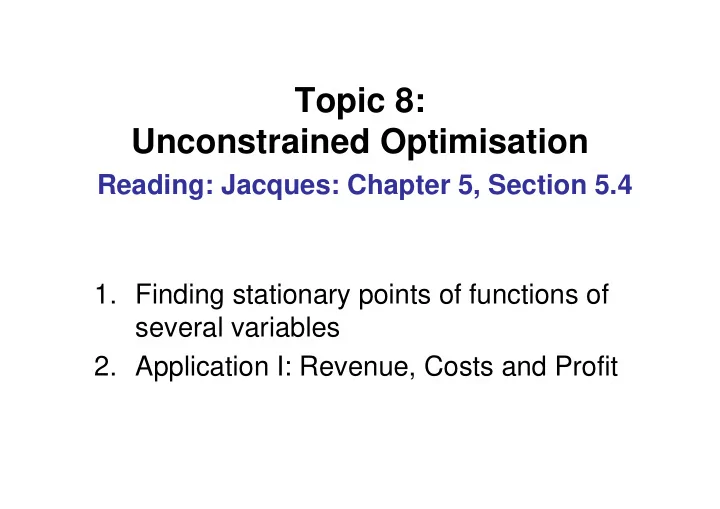

Topic 8: Unconstrained Optimisation Reading: Jacques: Chapter 5, Section 5.4 1. Finding stationary points of functions of several variables 2. Application I: Revenue, Costs and Profit
Stationary Points: Functions of one variable ( ) y = f x • First-order condition (necessary condition): dy ( ) = = f x ' 0 dx • Second-order conditions (sufficient conditions): • Second-order conditions (sufficient conditions): d y 2 ( ) 0 Maximum = < f x ' ' dx 2 d y 2 ( ) 0 = > Minimum f x ' ' dx 2
Stationary Points: Functions of several variables ( ) = y f x z , • The total differential of the function ∂ ∂ y y = + dy dx dz . . ∂ ∂ x z • First order conditions (necessary conditions): • First order conditions (necessary conditions): ∂ ∂ y y = + = dy dx dz . . 0 ∂ ∂ x z ∂ ∂ y y = = = = f f 0 0 and x z ∂ ∂ x z
Stationary Points: Functions of several variables • Classifying stationary points : • 3 possible turning points: • Minimum: increase in each direction
Minimum Y Z 0 X B
Stationary Points: Functions of several variables • Classifying stationary points : • 3 possible turning points: • Minimum: increase in each direction • Maximum: decline in each direction
Maximum A Y 0 X Z
Stationary Points: Functions of several variables • Classifying stationary points : • 3 possible turning points: • Minimum: increase in each direction • Maximum: decline in each direction • Saddle Points: increase in one direction, decline • Saddle Points: increase in one direction, decline in other direction
Saddle Point
Stationary Points: Functions of several variables • Second order conditions (sufficient conditions): – For minimum: 2 2 2 2 2 2 ∂ ∂ ∂ ∂ ∂ y y y y y > > − > , and . 0 0 0 ∂ ∂ x z 2 2 2 2 ∂ ∂ ∂ ∂ x z x z – For maximum: – For maximum: 2 ∂ 2 ∂ 2 ∂ 2 ∂ 2 ∂ 2 y y y y y < < − > , and . 0 0 0 ∂ ∂ x z ∂ 2 ∂ 2 ∂ 2 ∂ 2 x z x z – For saddle point: 2 ∂ 2 ∂ 2 ∂ 2 y y y − < . 0 ∂ ∂ x z ∂ 2 ∂ 2 x z
Stationary Points: Functions of several variables Summary ( ) = y f x z , ∂ ∂ y y • Total differential: = + dy dx dz . . ∂ ∂ x z ∂ ∂ y y = ⇒ = = dy and • First order conditions: 0 0 0 ∂ ∂ x z 2 2 ∂ ∂ ∂ ∂ ∂ ∂ y y y y y y 2 2 2 2 2 2 • Second order conditions: �������� ∇ = ��� − ∂ ∂ ∂ ∂ x z x z 2 2 ∂ 2 ∂ 2 y y > > ∇ > Minimum , and 0 0 0 ∂ 2 ∂ 2 x z 2 2 ∂ ∂ y y < < ∇ > Maximum , and 0 0 0 2 2 ∂ ∂ x z ∇ < 0 Saddle Point
Stationary Points: Functions of several variables • Example: Find and classify the stationary points of the function: ( ( ) ) = − + f x z x x xz 3 2 , 3
Application I: Revenue Costs and Profit • Example: The profit function of a firm producing 2 goods is given by π = + − − − Q Q Q Q Q Q 2 2 1000 800 2 2 1 1 2 2 1 1 1 1 2 2 2 2 ������������������� ����� ���������������������� Q Q 1 2
Application I: Revenue Costs and Profit • Example: A firm charges different prices for its goods to its domestic and export markets. The inverse demand equation for the = − P Q domestic market is given by 500 1 1 = − P . Q 360 1 5 and for the export market is given by 2 2 2 2 = 50000 + TC Q 20 The total cost function is = + Q Q Q where 1 2 What prices will the firm charge if it is to maximise its profits?
Application I: Revenue Costs and Profit • Example: A firms inverse demand function is given by = − + P Q A 0 . 5 100 2 8 Where A is expenditure on advertising, P is the price of the product and Q is the quantity demanded. In order to the product and Q is the quantity demanded. In order to produce Q units of output it costs the firm = + + TC Q Q AQ 2 4 (i) Find an expression for the firm’s profit in terms of A and Q (ii) Find the values of A and Q at which profits are maximised
Recommend
More recommend